Mosel wine travels: a wine travelling guest ramble by Molly Hovorka
The Mosel, heartland of the German Riesling, valley of steep slopes, home of castles and ruins - what better place to spend a holiday and taste some wine? Molly Hovorka, food-wine-travel blogger of Baking in Stilettos recently embarked on such a Mosel adventure, and she was kind enough to share her travel story with the Wine Rambler's readers - who may know her from a previous guest ramble, on the subject of Hungary's unique white wines. A highly recommended read, as is the following ramble on her Mosel adventure. Enjoy, and learn.

Mosel travels, a guest ramble by Molly Hovorka
It’s hard to believe that I’ve become such a lover of German wines. Years and years ago, I had the opportunity to attend a tasting of 40+ German wines from the West Coast’s top importer. To say I didn’t like them would be an understatement: I believe I described them as tasting like flat grape soda, and weak soda at that, and left having purchased two bottles of Spanish wine from the bargain bin.
I could kick myself today. No doubt we were tasting amazing wines that day; I believe the cheapest on the table was around $40/bottle and the prices went up sharply from there. Happily, my taste has changed and now nothing delights me more than the acidity, bright fruit, comparatively low alcohol content, and, most especially, the minerality of Mosel Riesling.

The Mosel is also one of my favorite places to travel in all of Germany. The lazily drifting, twisty-turny Mosel river flows 242 kilometers/145 miles from Trier to Koblenz, where it meets the Rhine. The river is lined with some of the world’s steepest vineyards: indeed, one winemaker we talked to grows grapes on a 70% incline. Of course, this being Germany, there are also plenty of storybook villages, castles, and forests along the way, making this area as interesting culturally as it is vinously.
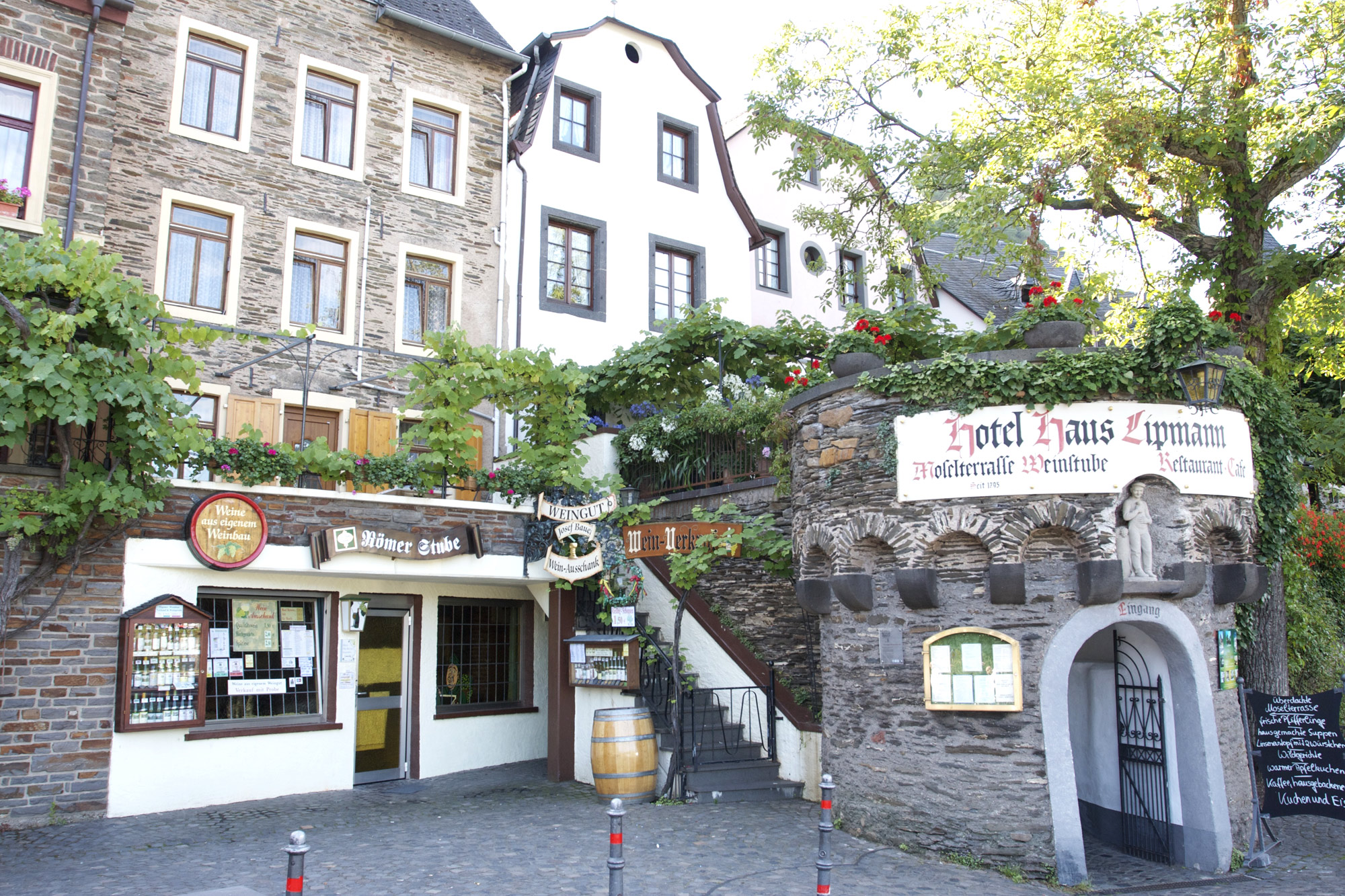
We based ourselves in Beilstein on a recent trip to the Mosel with some friends, a small medieval village on the lower Mosel. This town is so postcard-perfect that it feels like you are staying on a stage set. After a late night arrival, I awoke to the sound of ducks quacking in the river just across the street. OK, I’ll be honest — I’m not a morning person, so my initial reaction was not "Oh! How idyllic! Listen to the ducks!" but more "What the hell time is it and why the f*ck are those ducks going batshit outside?!?" Nonetheless, when I drew back the curtains to a view of the river and characteristic steep-sloped vineyards where the river turned, my annoyance quickly vanished and I jumped in the shower ready to start a day of exploring and wine tasting.
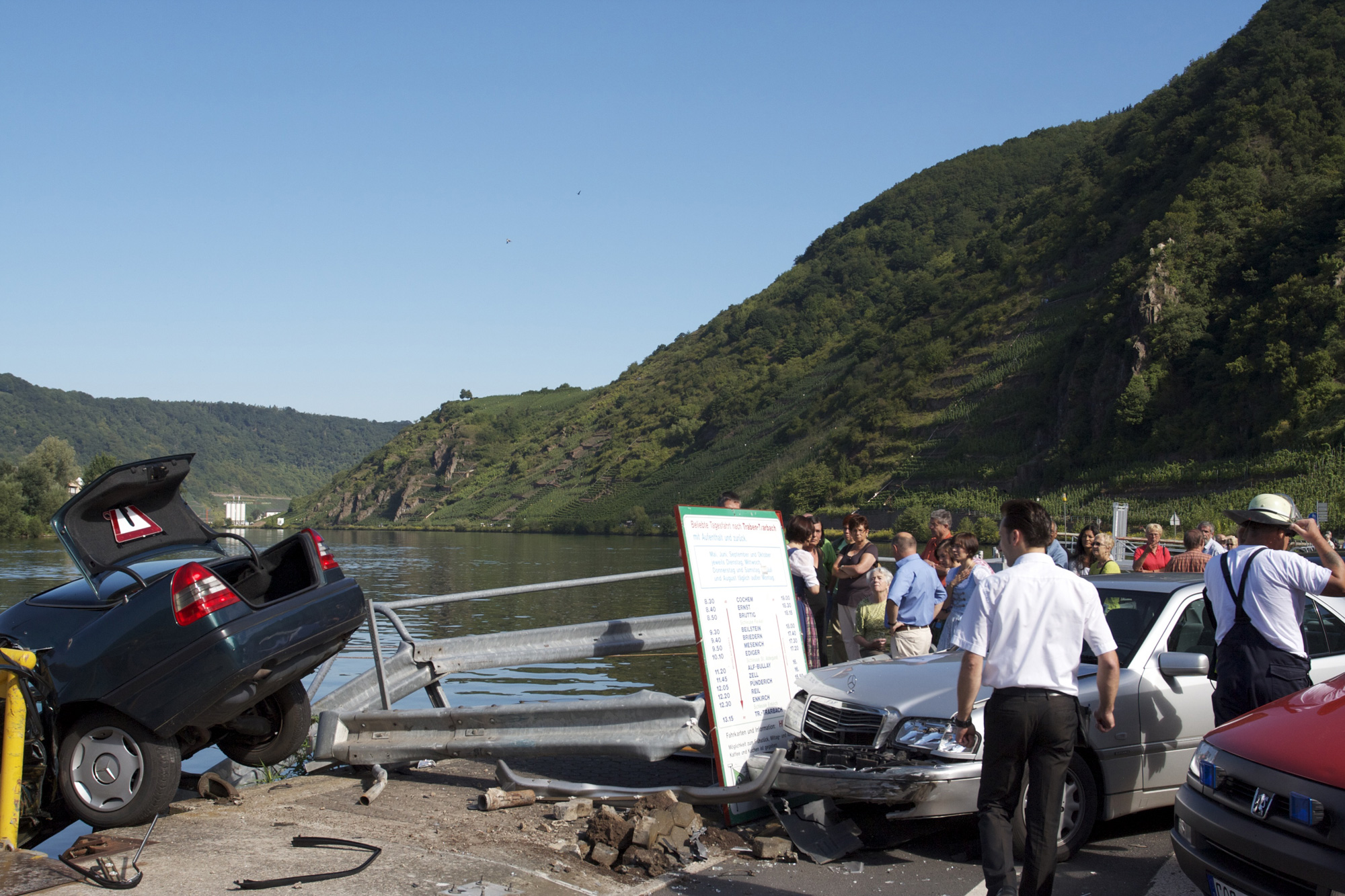
Our morning was not without adventure. After a filling and delicious breakfast (truly, German hotel breakfasts are the best hotel breakfasts in all of Europe), a US military plane from a nearby base did a low fly-by over the village. Perhaps related, or perhaps not, an elderly woman mistook her gas pedal for her brake pedal immediately after, and came flying down the hill, not stopping until she’d crashed through the guardrail next to the ferry dock, her car hanging precariously over the water.
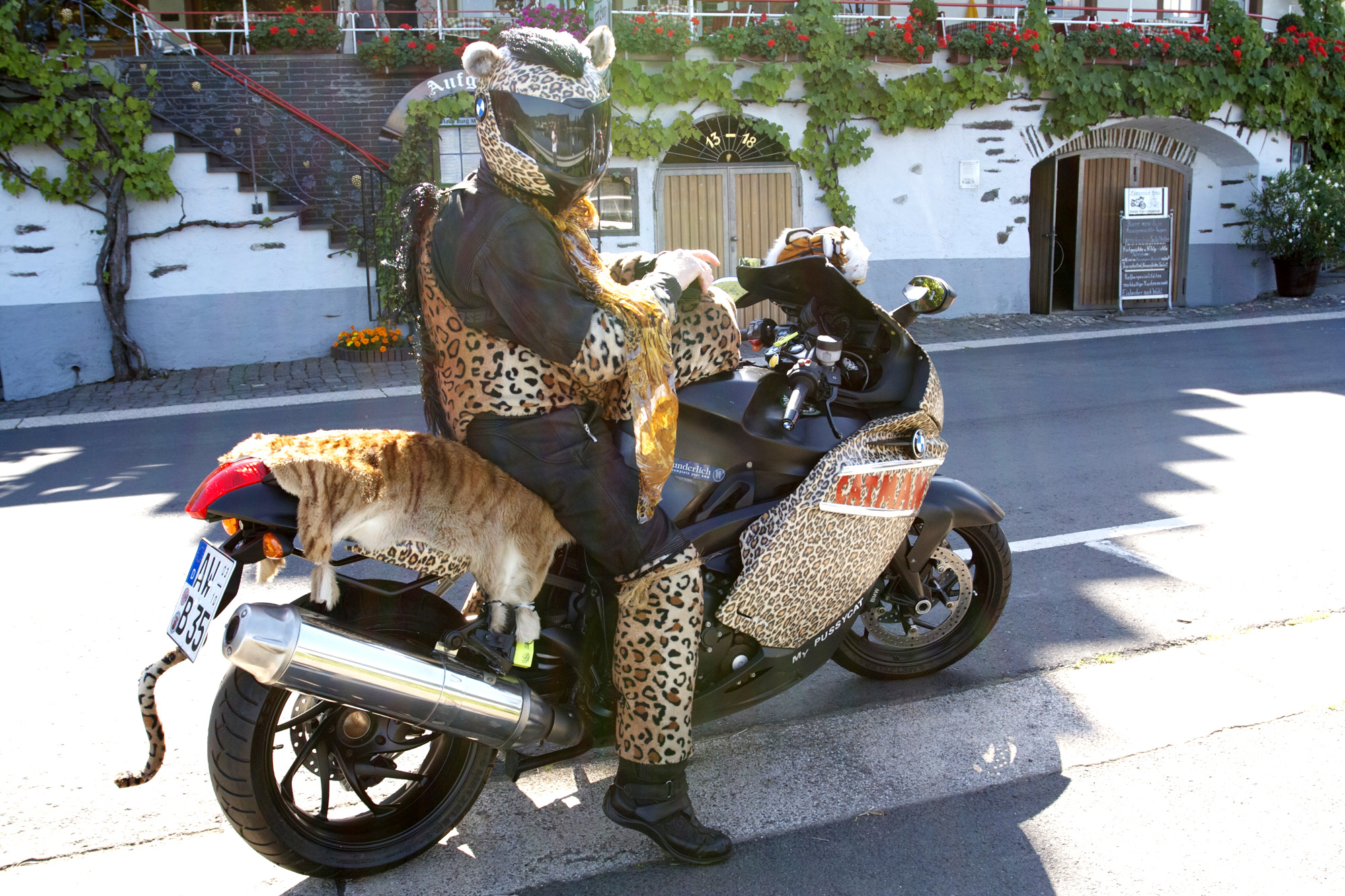
Thankfully no one was seriously hurt, but the ensuing hubbub did close the street for some time, during which a bird shat on my husband’s head and we saw a motorcyclist dressed head-to-toe like a cat, on a bike that was also decked out in full cat regalia.
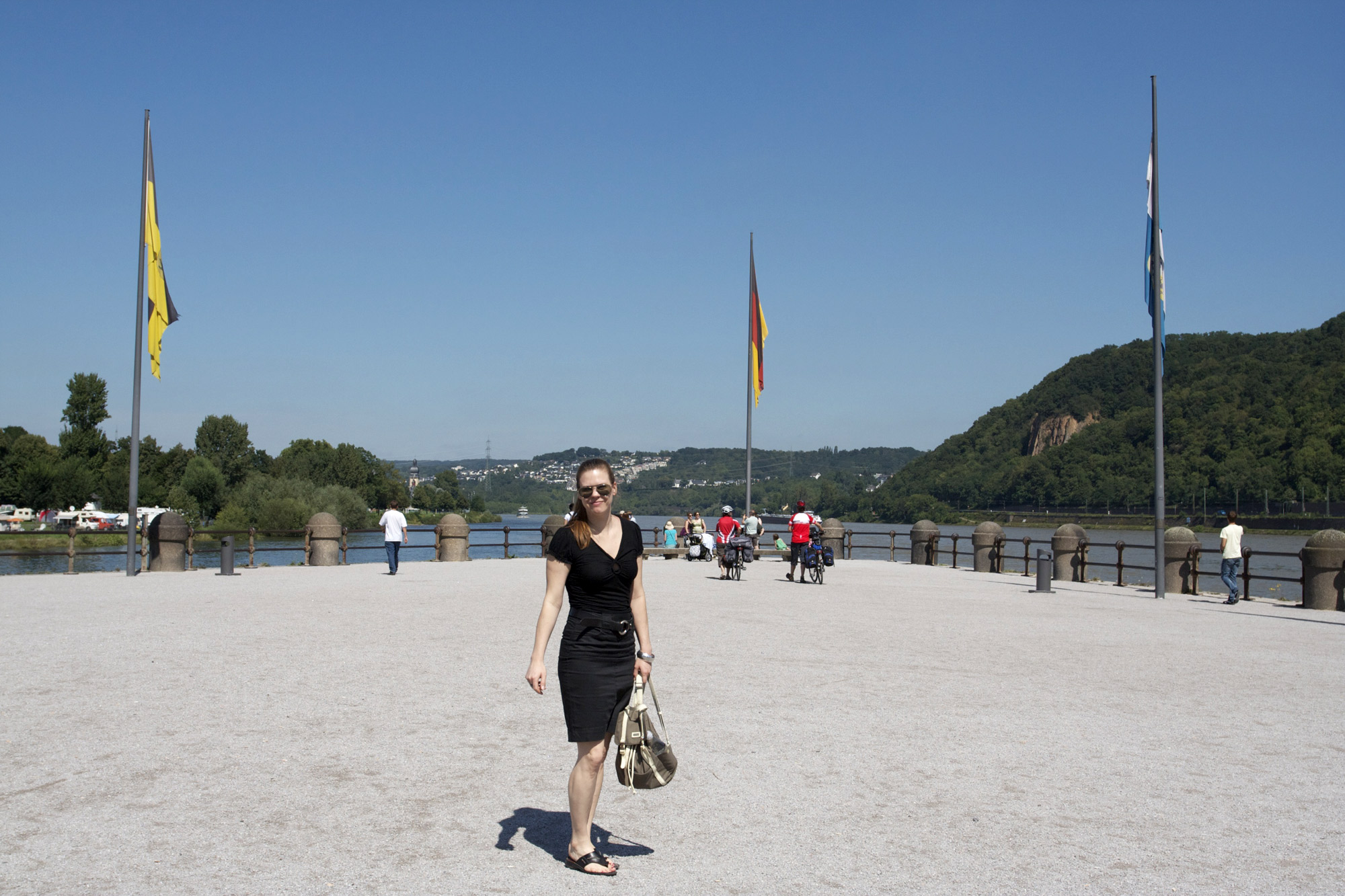
We started our day in Koblenz, a university town of a little over 100,000 people. Koblenz was heavily bombed in World War II, and is now a blend of restored buildings and more modern, post-war architecture. I wouldn’t call it one of the more charming cities in the area, but it does have a pleasant enough old town and an aerial tram spanning the Rhine up to the Ehrenbreitstein fortress, a spot that has been fortified since about 1000 B.C. It is also a convenient place to base yourself if you are planning to visit both the Rhine and the Mosel, though I personally prefer the smaller villages in the area.
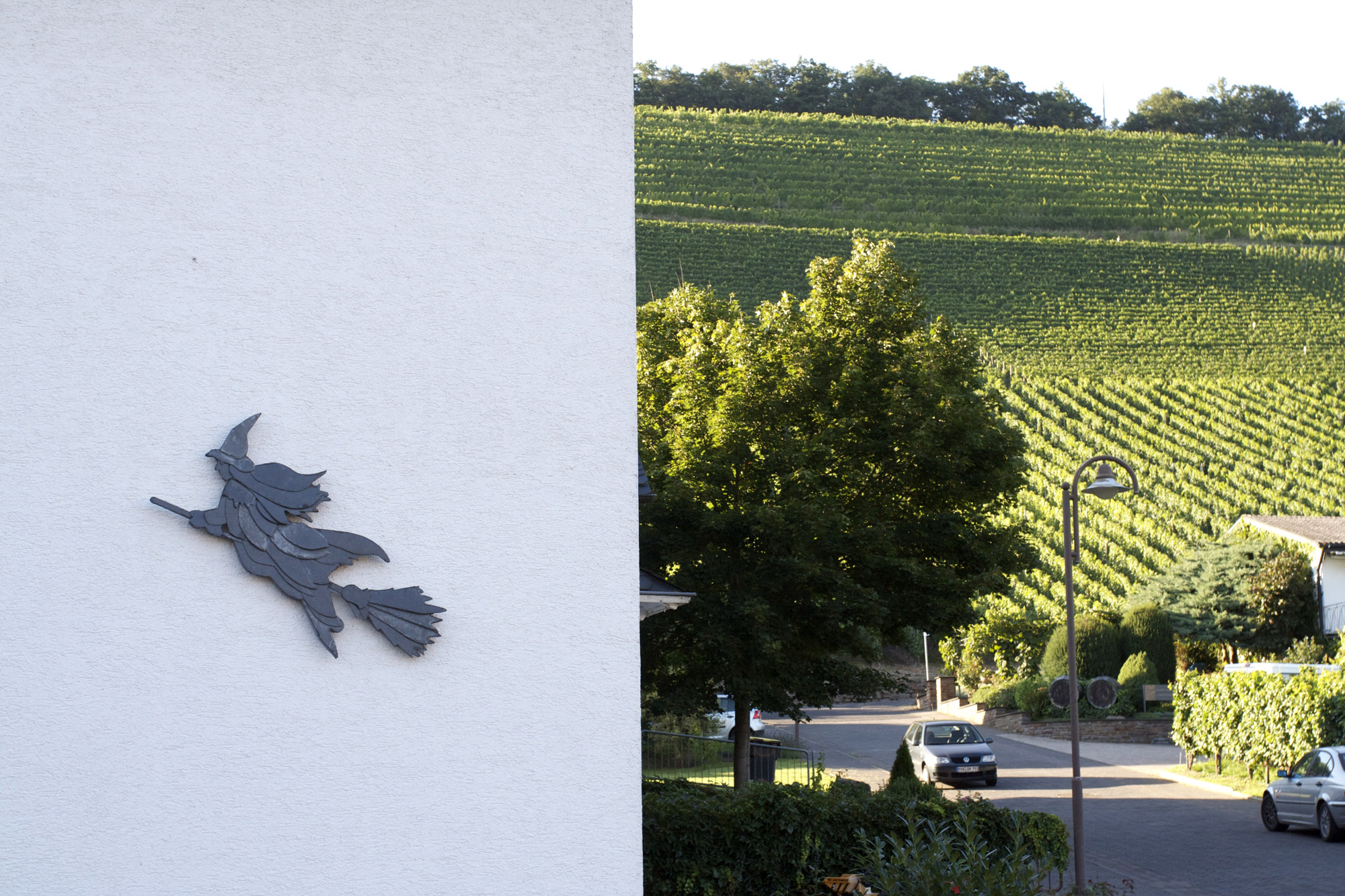
We had two appointments for wine tasting in the afternoon in Winningen, first at Weingut Heymann-Löwenstein and later at Weingut R & B Knebel. Winningen itself has a curious history, being the location of notorious 17th century witch hunts. One story tells of a wine grower allegedly catching a “witch” stealing from his best barrel just to find that she was his wife. Other stories uncover that accusations of witchcraft were the result of rivalries between men, with the wives of their rivals horribly bearing the brunt of such accusations. Today witchiness is part and parcel of the Winningen "brand." Nearly every house has a witch symbol affixed to its exterior, Weinhex (wine witch) is the collective name for the area’s vineyards, and the summer sees both a witch festival and Germany’s oldest wine festival, the latter of which is celebrated around the town’s Hexenbrunnen, or witches’ well.
Witches aside, we had a magical afternoon of wine tasting. Reinhard Löwenstein greeted our group of four, plus two other wine writers, for a cellar tour before our tasting session. I’d been told by Torsten of The Wine Rambler that Mr. Löwenstein is a character, and that certainly is a good way to put it. His cellar talk was one of the most interesting and wide-ranging I’ve ever heard, with topics including feng shui, the balance of light and dark, Dionysus, Kierkegaard, Goethe, Neruda, God, religion, organic farming, sex, workers’ rights, and how rules are bullshit. He also set my little bloggy heart a-twitter when he talked about the importance of writers, bloggers, and visitors in getting his message out. As a small producer in the world’s most labor intensive (and expensive) wine regions, PR and word-of-mouth takes on a heightened role for his marketing.
Our cellar tour was followed by a tasting with Reinhard’s wife, Cornelia. I don’t know if the Löwensteins pulled out the stops because there were writers in the group or if their tastings are always so extensive (it is not uncommon to taste a dozen or more wines at German tastings in my experience), but this ranked as the top tasting of my life. Cornelia led us through vertical tastings of several levels of Rieslings from their different vineyards, letting us handle slate samples from each vineyard so that we could see the differences in the soil as we progressed. In all we tasted some 20 wines over several hours, including two of the vineyard’s top labels.

The tasting would have continued for us had we not left to visit R & B Knebel nearby, where I’d been told to drop by in during the afternoon before 5:00. When I called at 4:45 to see if a short visit was still possible, Matthias Knebel graciously agreed to see us. Though he was initially prepared to run through an abbreviated tasting given the late hour, Matthias too wound up pulling out all the stops. Our tasting began with a comparison of two 1983 Rieslings, and ended with an absolutely magnificent Trockenbeernauslese from the family’s Röttgen vineyard. This last wine was one of those "wow" wines that I will remember forever, a true pivotal wine moment, and it was only a 2009.
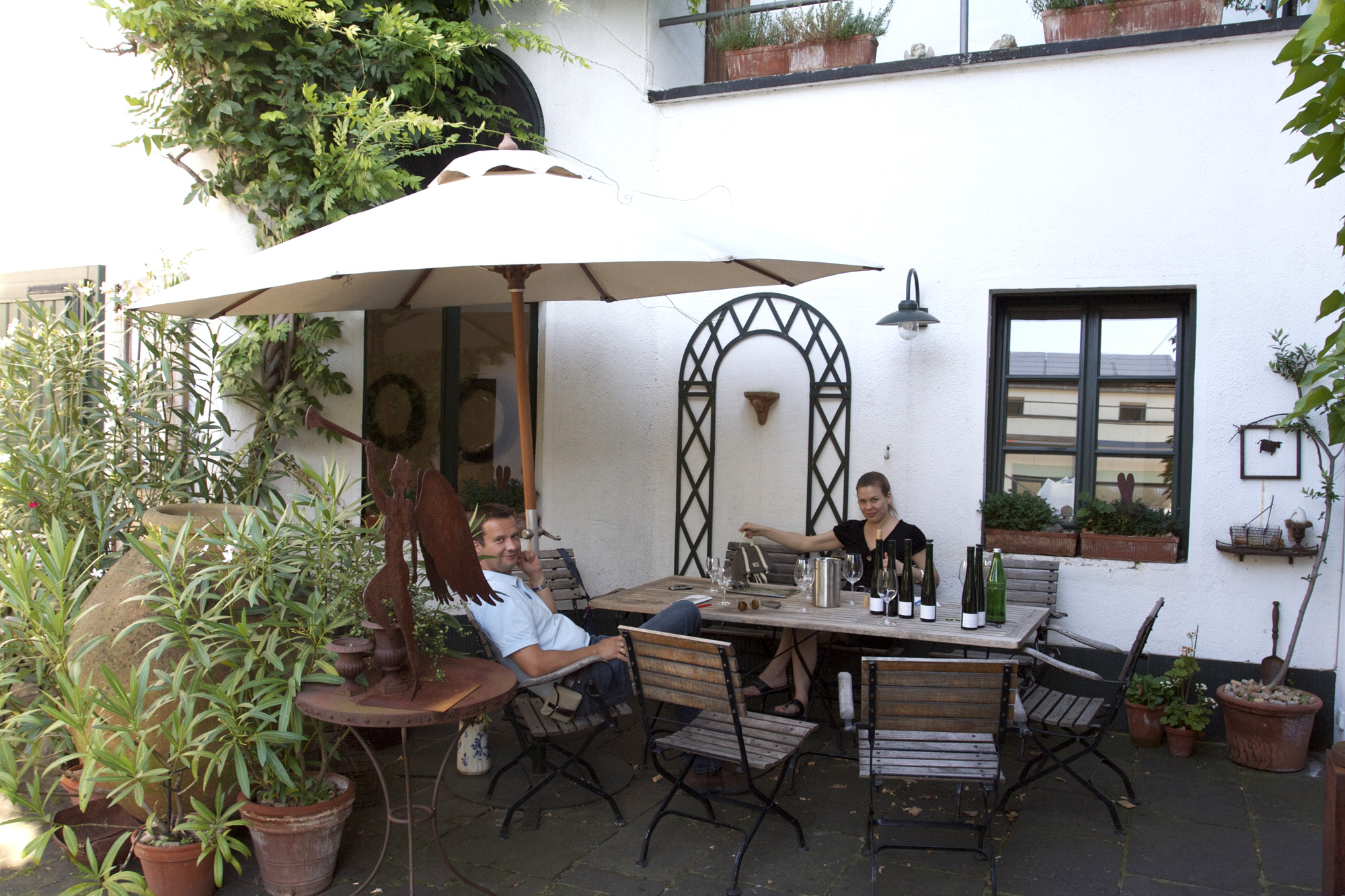
Our visit with Matthias was as personal as our visit to Heymann-Löwenstein was professional. We sat together outside in the afternoon sun, discussing wine, of course, but also village life, particularly when the town’s evening news was broadcast over outdoor speakers around town. We also learned what late harvest means in the Mosel, with grapes for Knebel’s ice wine being picked in December, and sometimes even after the new year. One memorable vintage was picked on Christmas Day. We also had a glimpse into the workings of this small winery (seven hectares), as Matthias told us about the Polish vineyard worker who comes to them every year, often bringing a relative, and who is considered like one of the family. Additional help for the harvest often comes from fans of Knebel’s wine — and this must truly be a labor of love as each grape is hand-picked on steep, steep slopes, as well as hand-sorted.

We stopped at Cochem, a beautiful but quite touristy town, on the way back to Beilstein. Cochem begins a particularly pretty section of the Mosel, with lots of twists, turns, and hilltop castles. We returned to this area the next day to tour Burg Eltz, a spectacular castle that has been occupied by the Eltz family for almost 1,000 years and some 30 generations. A tour takes you through 10 rooms and the treasury, giving an accurate view of what a 15th century nobleman’s castle looked like. It says something about people — we all like a good poop joke, after all — that one of the hits of the tour was seeing the indoor "toilets" in several of the rooms. These toilets were inside little wooden closets in the corner, and were flushed by rainwater collected on the roof, the sewage being discharged somewhere down in the valley.
We’d hoped to visit a few wineries in the Bernkastel-Kues area in the afternoon, home to the Mosel’s most prestigious Doctor vineyard. However, despite emails and calls requesting an appointment, none of the wineries on my list were able to see me. (There was a festival nearby that day, so perhaps this was the reason.) Weingut Dr. Pauly-Bergweiler did have an open tasting room in town, so we were able to sample a number of Bernkastel wines anyway, and we learned too that though the Doctor vineyard bears the schmancy name and higher pricetag, it does not necessarily produce the best wines wine the area.

We all fell in love with the town of Bernkastel-Kues, which to me is a good balance between the quiet perfection of Beilstein and the more touristy Cochem. Where Cochem has more amenities than tiny Beilstein, it also has a lot of tacky tourist shops that somewhat mask its character. Bernkastel-Kues also has the amenities, but it commercialism stops short of giving the town a too-touristy feel. Should we return to the Mosel, and I know we will, I will strongly consider staying in this town.
For a wine lover, two days is not enough time to scratch the surface in the Mosel, and one of my fantasy trips is to bike its full length some time, stopping at as many wineries as possible. Still, if you narrow your focus to one or two villages it makes an ideal place for a weekend trip.


Jealousy ensues...
Thank you for sharing your lovely photos and stories! You have inspired quite an envy in me and I am now eager to explore the Mosel myself. Your idea for a return trip on bicycle is fantastic, though I have to say after biking around Beaune for a day I found that wine tasting and cycling can be a difficult (if fun!) combination.
Did you ever find out what the catman was doing?
In reply to Jealousy ensues... by Sarah Chappell
Wondered about that
Considering I've been on a bike once in 10 years, I think this will remain strictly a fantasy. The route itself would be easy, but my peddling doesn't need to get any more wobbly! :-)
Catman was just out for a ride. Makes me wonder what his lair looks like.
Mosel tour
Molly, first of all thank you so much for sharing this with us - a really good read. I spent a week at the Mosel in 2008 and had a really good time there, so your travel story brought back lots of memories.
It also brought back much older memories. My grandparents decided to settle down near Koblenz, so as a child I went there every other year, and on most occasions we also went to Burg Eltz. I still remember the special toilets there, and somewhere in a basement in Munich are incriminating photos that show a ten year old Torsten posing with swords near the castle...
And Catman - I am lost for words.
Glad you enjoyed the Heymann-Löwenstein visit. I still haven't been there. So need to go soon!
Take care, and a big thank you again,
Torsten
Catman
Catman no doubt rules the land. Many thanks from me, too, Molly!
In reply to Catman by Julian
Cheers!
Torsten, Julien, the research was absolutely my pleasure. :-)
Great story and lovely
Great story and lovely places. I will def make a note to visit Bernkastel and Burg Eltz! Fabulous!